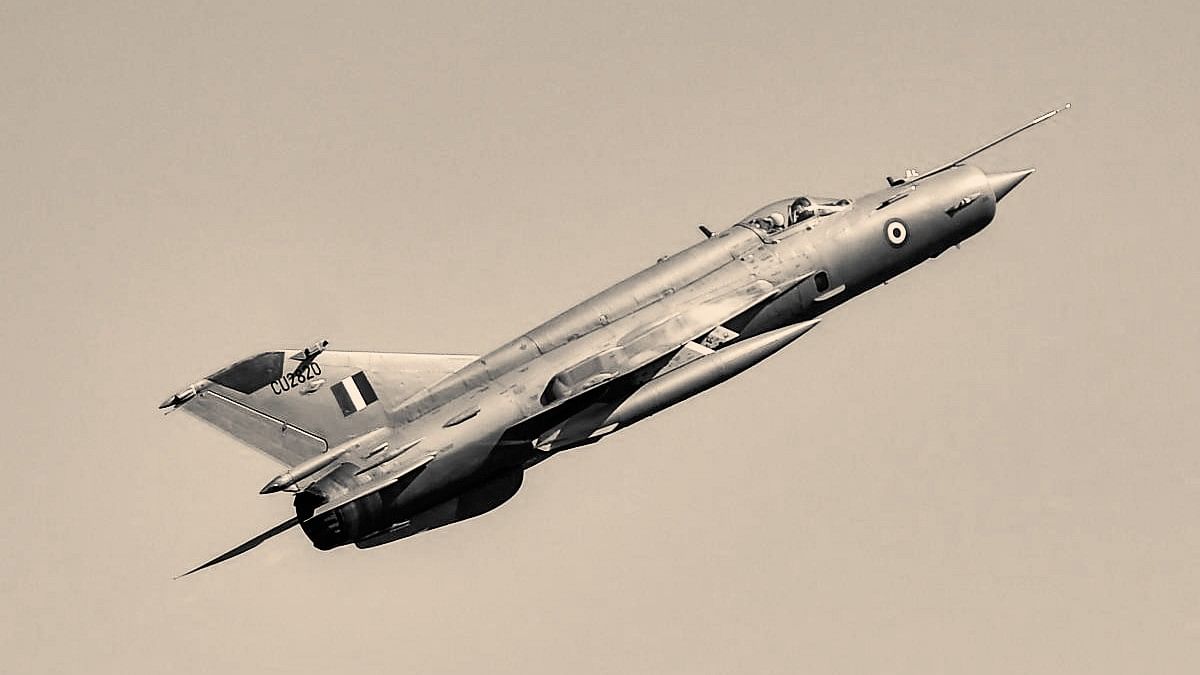
A MiG-21 aircraft.
Credit: PTI Photo
There must have been mixed feelings among those who watched the swansong sortie of the MiG-21 fighter jet on October 31 at the Uttarlai Air Force Station in Barmer in Rajasthan. It was joined in flight by a Su-30MKI fighter to mark the conversion of the Mig-21 Bison Squadron based at Uttarlai since 1966 into one of Su-30MKIs. Only two MiG-21 squadrons now remain in the Indian Air Force (IAF)’s fleet, and once they are phased out by 2025, a remarkable era in the history of the IAF will come to an end.
While the MiG-21 retreats, there are pressing questions about India’s air defence prowess. The IAF currently has less than 30 operational fighter squadrons of a sanctioned strength of 42 squadrons. With the MiG-21s gone, the fleet would be dangerously stretched at a time when there are major aerial threats on the eastern and western borders.
When the IAF acquired the supersonic MiG-21 from the former Soviet Union in 1963, nobody knew just how valuable it would prove to be over the next 60 years. The delivery of its second-generation interceptor variant had hardly started in 1964 when it found itself in the thick of battle in the India-Pakistan conflict of 1965. The MiG-21’s extraordinary dog-fighting ability made it the backbone of the IAF in the 1971 Bangladesh Liberation War, and the Kargil War with Pakistan in 1999.
With the Soviets granting India the licence to manufacture the MiG-21 in the subcontinent, the Hindustan Aeronautics Ltd (HAL) set up new plants at Nashik, Koraput, and Hyderabad for making airframes, engines, and avionics respectively. Soon several versions of the MiG-21 rolled out of these facilities. In the following decades, HAL built most of the 875 MiG-21s inducted into the IAF. This helped it hold sway over more modern aircraft like the Dassault Mirage 2000s and MiG-29s that joined the IAF fleet in subsequent years. In fact, age has been just a number for this ageing aerial warhorse as its numerous variants continued to hold their own even against fourth-generation jet fighters.
That said, the most versatile of the series, the Mig-21Bis fleet perhaps dominated the IAF’s fighter fleet for a year too many and — like all fighting machines — should have been phased out of service by more modern avatars. Yet, several factors, borne more out of necessity than tactical reasons, forced the IAF to make do and mend, flying the MiG-21 in various roles like ground attack, bombing, reconnaissance and providing cover for bombers. Such ad hocism also had much to do with the adamant refusal of the MiG-21’s vaunted successor, the Light Combat Aircraft (LCA), to leave the drawing board, defying deadlines.
With the pressing need to arrest a dwindling fleet, the IAF faced the Hobson’s choice of upgrading and continuing with its MiG-21 Bis fleet indefinitely, switching the fighter from its primary role of a short-range interceptor to that of a ground attack aircraft. Sadly, airbrushing the performance parameters of an aircraft like the MiG-21, primarily designed for high-speed interceptions, was never going to work — this was reflected in the unacceptably large number of crashes involving the fighter.
Like all aircraft, the MiG-21 has its idiosyncrasies. For instance, its high take-off and landing speeds — more than a jet airliner’s — meant the pilot had to think ahead of it, leaving little or no reaction time in an emergency. Moreover, bailing out from a MiG-21 is perilous compared to other fighter jets with an unacceptably high risk of spinal injury which often made pilots unwilling to eject. The crashes, of course, also had much to do with the way rookie pilots, used to obsolete basic trainers, leapfrogged technology to fly this frontline fighter. In fact, it is doubtful if the absence of an advanced jet trainer was so starkly demonstrated by any other major air force in the world.
Small wonder the sobriquet ‘Flying Coffins’ was plastered on the MiG-21s through most of their service life. Talk about giving a dog a bad name and hanging him. For in the hands of a good pilot, the MiG-21’s extreme manoeuvrability made it a feared fighter, especially in WVR (Within Visual Range) combat. It is too soon to forget how, in 2019, a MiG-21 Bison flown by Wing Commander Abhinandan Varthaman of the Srinagar-based No 51 squadron shot down an F-16 of the Pakistan Air Force.
The MiG-21 is a classic that has outlived all its contemporaries and has had several avatars since it first sported the IAF roundels. Much like what happened to the legendary German Messerschmitt EE-109 of the 1940s, however, the fine handling qualities of the initial Mig-21 versions were curiously missing in the later models that had to be upgraded. Indian planners shouldn’t have licence-built this magnificent flying machine without any strategic planning.
The lack of planning and timely action can also be seen in the gaps in our squadron strength. Phasing out jets and replacing them or even inducting new ones is a decades-long process. The induction of the indigenously-built LCA Tejas, along with some off-the-shelf and licence-built foreign platforms like the Dassault Rafale, may address the issue in the short term. But this will not be enough for the IAF to have even 35 fighter squadrons by 2030 -- surely a disturbing thought for defence planners as they watch the MiG-21 fly into the sunset.
Prakash Chandra is former editor of the Indian Defence Review. He writes on aerospace and strategic affairs.
Disclaimer: The views expressed above are the author's own. They do not necessarily reflect the views of DH.